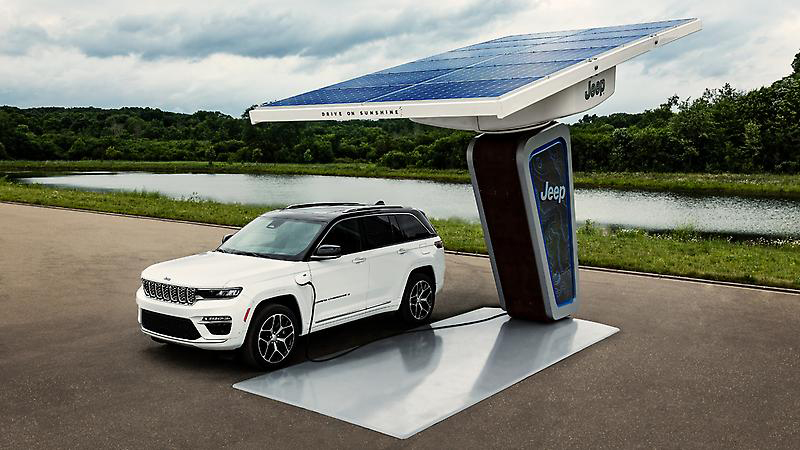
During Stellantis’ EV Day on July 8, the company revealed the first images of the 2022 Jeep Grand Cherokee 4xe plug-in hybrid, the first electrified model of the vehicle in its 30-year history.
The introduction of the Grand Cherokee 4xe is a step towards the Jeep brand and Stellantis’ move towards a zero-emission future. In Amsterdam, the company announced an intensification of its electrification targets while still targeting double-digit operating income margins in the mid-term.
“The customer is always at the heart of Stellantis and our commitment with this €30 billion plus investment plan is to offer iconic vehicles that have the performance, capability, style, comfort and electric range that fit seamlessly into their daily lives,” says Carlos Tavares, CEO of Stellantis. “The strategy we laid out today focuses the right amount of investment on the right technology to reach the market at the right time, ensuring that Stellantis powers the freedom of movement in the most efficient, affordable and sustainable way.”
The €36 billion investment plan runs through 2025 and focuses on electrification and software while continuing to be an industry leader in operational and investment efficiency.
The company is targeting more than 70 percent of sales in Europe and 40 percent of sales in the U.S. to be low-emission vehicles by 2030. Four flexible battery-electric vehicle (BEV) platforms that reach up to 500 miles of range with 20 miles per minute fast charging capability will be the automaker’s technological focus.
Stellantis plans to achieve increased profitability in the coming years. This will be supported by the execution of the synergy opportunities arising from the formation of Stellantis, with a forecast of annual cash synergies of more than €5 billion at steady state, the roadmap of battery cost reductions, and the continued optimization of distribution and production costs and realization of new revenue streams, in particular from connected services and future software business models.
The company is targeting to achieve sustainable, double-digit adjusted operating income margins in the mid-term — around 2026 — making the company a benchmark in profitability in the provision of electrified mobility to customers on a global basis.
The Stellantis electrification roadmap encompasses the entire value chain. The company’s EV battery sourcing strategy is to secure more than 130 gigawatt hours (GWh) of capacity by 2025 and more than 260 GWh by 2030. The EV battery and component needs will be met with a total of five “gigafactories” in Europe and North America, completed with additional supply contracts and partnerships to support total demand.
Two lithium brine process partners have signed memorandums of understanding with Stellantis to ensure a steady and localized supply of the most critical raw material in battery production, while simultaneously integrating it into the supply chain.
The company intends to maximize the full value of the battery life cycle through repair, remanufacturing, second-life use and recycling, as well as ensure a sustainable system that prioritizes customer needs and environmental concerns.
The four BEV-centric platforms are the foundation of the electrified vehicles from Stellantis brands. The platforms are designed with size flexibility and component sharing, delivering economies of scale as each platform can support production of up to 2 million units per year.
The four platforms are:
- STLA Small, with a range up to 300 miles (500 kilometers)
- STLA Medium, with a range up to 440 miles (700 kilometers)
- STLA Large, with a range up to 500 miles (800 kilometers)
- STLA Frame, with a range up to 500 miles (800 kilometers)
Propulsion includes a family of three electric drive modules (EDM) that combine the motor, gearbox, and inverter. These EDMs are compact, flexible and scalable and can be configured for front-drive, rear-drive, all-wheel drive and 4xe.
“Our electrification journey is quite possibly the most important brick to lay as we start to reveal the future of Stellantis just six months after its birth, and now the entire company is in full execution mode to exceed every customer’s expectations and accelerate our role in redefining the way the world moves,” says Tavares. “We have the scale, the skills, the spirit and the sustainability to achieve double-digit adjusted operating income margins, lead the industry with benchmark efficiencies and deliver electrified vehicles that ignite passion.”





